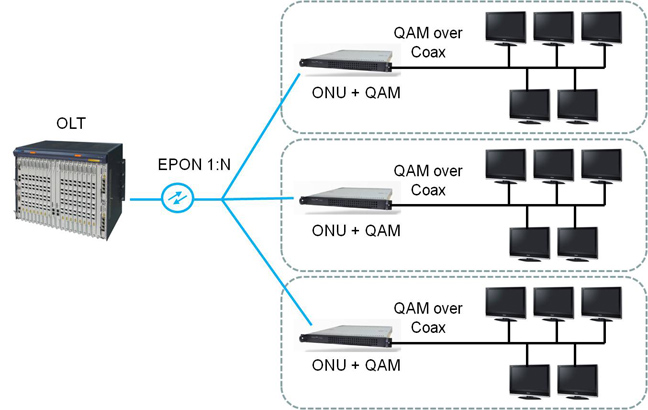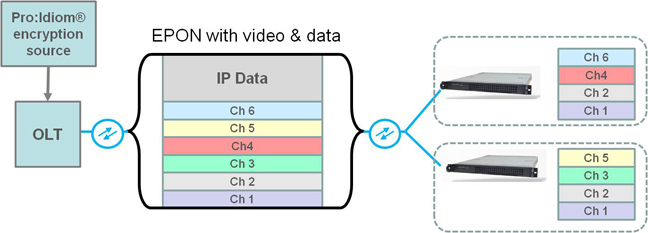Using EPON-To-QAM Gateways For Commercial Purposes
Ethernet Passive Optical Network (EPON) solutions are becoming popular for commercial services in the North American cable market. Today, MSOs are using EPON primarily to deliver high-speed data and voice to business users, and for backhauling of digital traffic from cellular radio towers.
The industry is making rapid progress on the Data Over Cable Service Interface Specification (DOCSIS) Provisioning over EPON (DPoE) to allow the use of existing DOCSIS backend and provisioning models for EPON. Current 1 Gbps symmetric EPON systems are easily upgraded to 10 Gbps – either symmetric (10 Gbps upstream/10 Gbps downstream) or asymmetric (10 Gbps downstream/1 Gbps upstream), and these new 10 Gbps systems can run both 1 Gbps and 10 Gbps services simultaneously. The increasing presence and capacity of EPON and its built-in multicast/broadcast capability make it attractive for delivering video services to commercial users.
One proposed service is to deliver high-quality high-definition (HD) and standard-definition (SD) digital programming to hospitality-type accounts. Such commercial users as hotels, time-share condos, hospitals and healthcare facilities, health clubs and others are asking for high-video quality digital programming to leverage the new HD-resolution, flat-panel displays they have been deploying. A standard lineup of HD and SD channels likely would require between 16 QAMs and 32 QAMs (assuming between 2 and 3 HD channels per QAM and between 10 and 12 SD channels per QAM). EPON can be used to augment an existing TV service by supplying niche channels demanded by users, such as foreign programming or additional sports programming.
EPON offers a low-cost way to deliver these services to these facilities by using an EPON-to-QAM gateway to send the digital video to QAM-ready digital TVs. Most hospitality accounts today use satellite-delivered video content and require an extensive amount of on-premises equipment. EPON enables cable or telco operators to supply video services to these properties at lower cost with less complexity.
 |
| EPON-To-QAM Gateway System (OLT image courtesy of ZTE) |
The device required to terminate the EPON fiber and to deliver HD and SD video over coax using QAM modulation should be low-cost, compact, reliable and optimized for this service. Because the EPON fiber typically is terminated directly at the property, an ideal EPON-to-QAM gateway only requires one or two RF ports, each populated with between 16 and 32 QAMs. Figure 1 shows a high-level view of the EPON system and EPON-to-QAM gateway.
Why EPON?
Consumers have come to expect high-quality video, notably in the form of HDTV. The new TVs take full advantage of high-resolution video content supplied on DVDs, Blu-Ray discs, and carrier-delivered HD and SD channels.
The hospitality and healthcare industries, well-aware of this situation, have been upgrading their TVs to large-format, wide-screen, flat-panel units for the last few years, and they need high-quality HD and SD digital video. Traditional analog video results in an unsatisfactory user experience for video and audio quality. However, the economics of the hospitality industry demand that a service provider deliver these channels at low cost. In addition, many content owners must be assured that the content is secured to avoid piracy, particularly with premium channels. Historically, it has been expensive for cable operators to deliver video service to these properties using traditional hybrid fiber coax (HFC) architectures and standard residential video feeds. There are a number of reasons for this:
• Far distance from residential cable plant;
• Custom content packages requiring the need to deliver dedicated line-ups;
• Cost of new devices at each TV due to technologies, including switched digital video (SDV); and
• High costs and complexity of legacy cable-TV content protection.
The hospitality industry has on-premise equipment in place now that is ready to support SD and HD video. Most flat-panel digital TVs purchased during the last five years have built-in QAM tuners that can demodulate and decode un-encrypted digital TV channels sent from a cable operator. For security purposes, hotels and most hospitality industries use a content protection scheme called Pro:Idiom (licensed by the Zenith division of LG Electronics), endorsed by the content industry for security in hospitality environments. This either is incorporated directly in the TV or in a side-car box supplied by various third parties.
In standard installations, the Pro:Idiom encryption is performed at the customer’s premises, typically in conjunction with a satellite, off-air or cable receiver. The encrypted channels then are delivered via the internal coax cable distribution system of the property to Pro:Idiom-equipped TVs.
The encryption source device requires a Pro:Idiom license for every transport stream and can encrypt up to six programs in that transport stream. A 48-channel HDTV service (2 HD channels per QAM) would require at least 8 licenses for each unit (before manufacturer markup), assuming 6 HD programs are placed in 1 multi-program transport stream (MPTS) before the encryption module, and then re-multiplexed into 3 MPTS (2 HD channels per MPTS) after the encryption module. Without remultiplexing at the local premises, 24 licenses would be required (1 per MPTS containing 2 HD channels).
For the EPON-to-QAM application, the channels are encrypted with Pro:Idiom at the cable operator’s network operations center just once; one Pro:Idiom encryption source can serve multiple properties, saving substantial licensing costs.
Video Broadcast/Multicast
EPON systems consist of an optical line terminal (OLT), typically housed in a cable hub and connected to an IP content source (such as an Internet connection or a digital video source delivered from a cable headend). The OLT feeds IP traffic to a set of optical network units (ONU) via Ethernet over passive optical fiber. The OLT to ONU connection is point-to-multipoint using fiber optics and a set of passive optical splitters to fan out to many ONU devices, typically between 32 or 64, depending on the optical budget. The downstream traffic is broadcast or multicast by the OLT to the ONUs (that select the content intended for them), and the upstream traffic is managed by the OLT using Time Division Multiple Access (TDMA) so that each ONU has its own upstream time slot.
The multicast nature of the downstream transmission path reportedly is ideal for low-cost delivery of digital video broadcast services. As shown in Figure 2, each ONU terminal device can join any of the multicast channels to form the local line-up for each property, and there is no need to send multiple copies of any channels on the EPON.
 |
| Building Custom Channel Lineups |
Current EPON systems use ONUs that have symmetric 1 Gig capabilities, i.e., 1 Gbps of downstream and 1 Gbps of upstream capacity. A 1 Gbps EPON ONU typically can carry 24 QAM channels (using 256 QAM mode, Annex B, delivering 38.8 Mbps of traffic per QAM), adequate for a smaller digital broadcast service mix of HD and SD channels. An ONU can be dedicated for the video service or shared with a data service. Recently introduced 10 Gbps systems can support a full 10 Gbps of downstream traffic (with either 10 Gbps or 1 Gbps upstream capacity), so a shared video and data service is practical. These systems also support larger video channel lineups.
EPON-To-QAM Gateway
The conversion between the EPON network and the QAM network delivered to the QAM-tuner TVs is accomplished with an EPON-to-QAM gateway, an integration of an EPON ONU and an IP-enabled edge QAM or IPQAM. IPQAMs are available in many configurations and price points for different applications. The EPON-delivered broadcast video application for hospitality users has a different profile than most other edge QAM applications.
For standard residential services, edge QAMs typically are deployed in a hub, and they support both broadcast video services ( e.g., broadcast channels with zoned advertising) and narrowcast video services (VOD and SDV, perhaps with targeted advertising). In a modular cable modem termination system (CMTS) environment, they also support DOCSIS-based data and voice services.
Hubs can serve many thousands or tens of thousands of homes, so it is common to deploy edge QAMs with extremely high QAM capacities, many RF ports (one per narrowcast service group or more in some redundancy schemes), and multi-service capabilities. Some operators leverage this type of architecture to deliver a dedicated broadcast service to hospitality accounts if the properties are served by the cable’s HFC plant.
For a commercial broadcast service, an EPON-to-QAM gateway typically serves one or only a few buildings. Thus, the capacity and RF port count of this type of QAM gateway is greatly reduced when compared to a typical hub-based universal edge QAM. For a simple 1 Gbps EPON connection, 24 QAMs can be used to deliver between 48 and 72 HD channels, depending on the amount of digital compression used. A system with one or two RF ports (if two different channel lineups are required) is all that is required; each RF port contains 24 QAMs. A broadcast service doesn’t require interactive links to VOD or SDV session managers, so the QAM gateway can be simple and low-cost.
An optimal solution that can be used as the basis for a simple 1 Gbps EPON-to-QAM system is a compact 1RU (1 rack unit, 1.75 inches high) IPQAM with 1 RF port, 24 QAM capacity and 1 Gbps input. In a 10 Gbps EPON system, the EPON-to-QAM gateway can be expanded to have more QAMs. The ONU functionality currently is available as a pluggable SFP module for 1 Gbps EPON from such vendors as Finisar. XFP (10-Gig small form factor pluggable) and SFP+ pluggable packages for 10 Gig EPON are expected by next year. Together, as shown in Figure 3, a SFP ONU combined with an optimized IPQAM design creates an ideal EPON-to-QAM gateway for the commercial broadcast video application.
 |
| IPQAM Plus SFP ONU (SFP ONU image courtesy of Finisar, IPQAM image courtesy of BroadLogic) |
Alternative edge QAM solutions typically are not designed to have a small number of high-QAM density RF ports; they all have a large number of RF ports that can be either low-density (4 or 8 QAMs per port) or high-density (24 and higher per RF port). A 24-QAM (one RF port with 24 QAMs) broadcast video EPON-to-QAM solution can be built with existing silicon, such as the BroadLogic BL85000 TeraQAM QAM modulator chip and SFP ONU devices at a fraction of the cost of a standard multi-port edge QAM design. This, combined with the low cost of 1 Gbps and 10 Gbps EPON and centralized Pro:Idiom encryption sources, makes for an attractive and affordable solution to serve commercial hospitality users.
Richard Peske is vice president/Marketing at BroadLogic Network Technologies Inc. Contact him at rpeske@broadlogic.com.